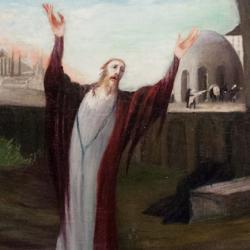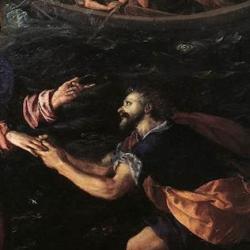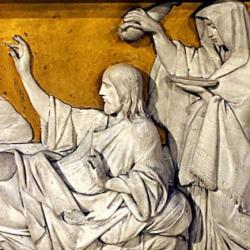Matthew 21:23-25 (possible 26:16) all takes place on a single day. Jesus comes to the temple a second time, wrangles with the priests and Pharisees, prounounces woes over them, predicts the destruction of the temple and the final review of sheep and goats. This is the “day of Yahweh,” the day of Yahweh’s visitation to Israel, the day that seals their doom just as much as the day they put Jesus on trial. After this day, Jesus leaves the temple and never returns.
21:23-22:46 forms a unit within this larger section. It is set up like this:
The passage is framed by concern for Jesus’ authority. “Who gave you authority to do these things?” (21:23) is the question that initiates the action, and the series of confrontations ends with Jesus raising a question about the Christ as David’s “Lord” or master (22:41-46). After that, the Jewish leaders are silent, and speak to Jesus only at His trial.
Within this frame there are two sequences of three. In response to the question, Jesus tells three parables: the two sons in the vineyard, the tenants of the vineyard, and the wedding feast. These describe Israel’s history of rebellion from various angles. Yahweh’s relation is Father-son, and the kingdom is a place of labor; Yahweh’s relation is Landowner-tenants, and the kingdom is a place that is to bear fruit; Yahweh’s relation is, finally, King-guests, and the kingdom is a wedding feast.
The parables also all have a son or sons. The Jewish leaders are the faithless son of the first parable, but in the last two parables Jesus is clearly the Son, who first comes to collect rent and is killed and then is the bridegroom at a wedding feast. Perhaps we are to take the parables in sequence (at one level): The murdered Son reappears in the following parable at a wedding feast. That’s an answer to the Sadducees before they ask their question about resurrection.
The three parables are followed by three temptations, about tribute to Caesar, the resurrection, and the greatest commandment. Three of Israel’s chief conflicts in the period – relation to Rome, eschatology, and the law. They are temptations (22:18), and perhaps they match roughly with the three temptations of Satan that followed Jesus’ baptism: The coin matches the temptation to turn stones to bread, the resurrection question is related to the temptation to test God, and the question about the law is a question about ruling the earth. Maybe.
If we add the final question that Jesus poses about Psalm 110, we get a heptamerous sequence, which might roughly match the days of creation. Day 1 would match the parable of the two sons, but that connection is not obvious; the vineyard is the “firmament,” which works especially if we see the vineyard as the temple; the wedding feast parable matches Day 3, when wheat and fruit first appear on the earth; the question about tribute money matches Day 4, the day of heavenly rulers; the connection of Day 5 with the question of resurrection is not clear; on Day 6, the day of Adam, Jesus teaches the duty of man to love God and neighbor; Psalm 110 is an enthronement Psalm, a Psalm of Sabbath victory and rest. Maybe again.











